Stellar streams
Large galaxies have dozens of dwarf galaxies orbiting around them, mainly of the spheroidal or irregular type. These galaxies are called satellite galaxies because they revolve around another larger host galaxy. In the 3D model of the Local Group of galaxies you can learn about the satellite galaxies of Andromeda and the Milky Way.
Satellite galaxies are under the influence of the intense gravitational force of the central galaxy, which in some cases causes them to gradually dismember due to the tides it induces in them: the host galaxy attracts gas, dust and, above all, stars from the satellites as they revolve around it, with stellar arcs appearing along their trajectories in space. These streams are technically called stellar streams.
The Sagittarius Dwarf Spheroidal galaxy
It is a small galaxy with the appearance of an elongated ball and about 10,000 light-years in diameter, captured by our own about 4 or 5 billion years ago. Its orbit around the Milky Way is polar, that is, it moves perpendicular to the disk of our galaxy passing through the north and south galactic poles, approaching up to about 50,000 light-years from the center of our galaxy.
The tidal forces caused by the Milky Way on Sagittarius are causing its gradual dismemberment. In the sky we can see arc-shaped structures that are the trails of stars that are being torn from the dwarf galaxy. This stellar stream is not the only one that has been identified in our Galaxy, but it is the most prominent and best studied.
The 3D model
In this 3D model, we easily identify the Milky Way in the center, with its characteristic spiral arms around the bulge, or nucleus. Attached to the disk is an elongated bulge: it is the Sagittarius spheroidal dwarf galaxy, which is currently very close to the disk of our galaxy.
Starting from Sagittarius and perpendicular to the galactic disk, we can follow the structure of the stellar stream formed by the trail of stars that the Milky Way has stolen from Sagittarius. The small bulges represent stars, and the lattice in which they are found can be interpreted as the gas and dust they have dragged with them.
The presence of loops in the stream indicates that Sagittarius has completed several orbits around the Milky Way, roughly always in the same plane of space passing through the galaxy’s north and south poles, as expected.
In the model, the size of the Milky Way’s disk has been exaggerated to be able to connect it to the stellar current, which in reality is not attached to our galaxy.
The model has been created by Emilio Terol (OAUV), Alberto Fernández Soto (IFCA) and David Martínez Delgado (CEFCA) using real data obtained with the European satellite Gaia, which has measured the positions of one billion stars with great precision.
This work has been carried out with a grant from the R&D&I ‘Proof of Concept’ 2022 (PDC2022) call for projects, financed by the European Union through the NextGenerationEU Recovery, Transformation and Resilience Plan. Project’s reference: PDC2022-133930-I00.

